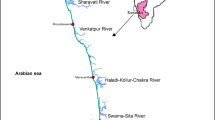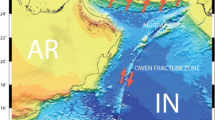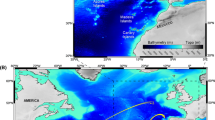Abstract
A probabilistic tsunami hazard assessment is performed for the Makran subduction zone (MSZ) at the northwestern Indian Ocean employing a combination of probability evaluation of offshore earthquake occurrence and numerical modeling of resulting tsunamis. In our method, we extend the Kijko and Sellevoll’s (1992) probabilistic analysis from earthquakes to tsunamis. The results suggest that the southern coasts of Iran and Pakistan, as well as Muscat, Oman are the most vulnerable areas among those studied. The probability of having tsunami waves exceeding 5 m over a 50-year period in these coasts is estimated as 17.5%. For moderate tsunamis, this probability is estimated as high as 45%. We recommend the application of this method as a fresh approach for doing probabilistic hazard assessment for tsunamis. Finally, we emphasize that given the lack of sufficient information on the mechanism of large earthquake generation in the MSZ, and inadequate data on Makran’s paleo and historical earthquakes, this study can be regarded as the first generation of PTHA for this region and more studies should be done in the future.








Similar content being viewed by others
References
Ambraseys NN, Melville CP (1982) A history of Persian earthquakes. Cambridge University Press, Britain
Annaka T, Satake K, Sakakiyama T, Yanagisawa K, Shuto N (2007) Logic-tree approach for probabilistic tsunami hazard analysis and its applications to the Japanese coasts. Pure Appl Geophys 164:577–592
Berninghausen WH (1966) Tsunamis and seismic seiches reported from regions adjacent to the Indian Ocean. Bull Seismol Soc Am 56(1):69–74
Burbidge D, Cummins PR, Mleczko R, Thio H (2008) A probabilistic tsunami hazard assessment for Western Australia. Pure Appl Geophys 165:2059–2088
Burroughs SM, Tebbens SF (2005) Power-law scaling and probabilistic forecasting of tsunami runup heights. Pure Appl Geophys 162:331–342
Byrne DE, Sykes LR, Davis DM (1992) Great thrust earthquakes and aseismic slip along the plate boundary of the Makran subduction zone. J Geophys Res 97(1B):449–478
Dominey-Howes D, Cummins P, Burbidge D (2007) Historic records of teletsunami in the Indian Ocean and insights from numerical modeling. Nat Hazards 42(1):1–17
Gardner JK, Knopoff L (1974) Is the sequence of earthquakes in southern California, with aftershocks removed, Poissonian? Bull Seismol Soc Am 64:1363–1368
Geist EL, Parsons T (2006) Probabilistic analysis of tsunami hazards. Nat Hazards 37:277–314
Goto C, Ogawa Y, Shuto N, Imamura F (1997) Numerical method of tsunami simulation with the leap-frog scheme. (IUGG/IOC Time Project), IOC Manual, UNESCO, No. 35
Gutenberg B, Richter CF (1954) Seismicity of the earth and associated phenomena, 2nd edn. Princeton University Press, NJ, USA
Harvard Seismology (2007) Global CMT catalog search, www.globalcmt.org. Harvard University, Cambridge, MA, USA
Heck NH (1947) List of seismic sea wave. Bull Seismol Soc Am 37(4):269–286
Heidarzadeh M, Pirooz MD, Zaker NH, Synolakis CE (2008) Evaluating tsunami hazard in the northwestern Indian Ocean. Pure Appl Geophys 165(11–12):2045–2058
Heidarzadeh M, Pirooz MD, Zaker NH, Yalciner AC (2009) Preliminary estimation of the tsunami hazards associated with the Makran subduction zone at the northwestern Indian Ocean. Nat Hazards 48(2):229–243
International Seismological Centre (ISC) (2007) On-line bulletin, http://www.isc.ac.uk. International Seismological Centre, Thatcham, UK
IOC, IHO, BODC (2003) Centenary edition of the GEBCO digital atlas, published on CD-ROM on behalf of the Intergovernmental Oceanographic Commission and the International Hydrographic Organization as part of the general bathymetric chart of the oceans. British Oceanographic Data Centre, Liverpool
Kijko A (2004) Estimation of the maximum earthquake magnitude m max. Pure Appl Geophys 161:1655–1681
Kijko A, Sellevoll MA (1992) Estimation of earthquake hazard parameters from incomplete data files. Part II: incorporation of magnitude heterogeneity. Bull Seismol Soc Am 82(1):120–134
Lin IC, Tung CC (1982) A preliminary investigation of tsunami hazard. Bull Seismol Soc Am 72(6):2323–2337
Mansinha L, Smylie DE (1971) The displacement field of inclined faults. Bull Seismol Soc Am 61(5):1433–1440
McCaffrey R (2007) The next great earthquake. Science 315:1675–1676
Merewether W (1852) A report of the disastrous consequences of the severe earthquake felt in the provinces of Upper Scinde on the 24th January 1852. J Bombay Geogr Soc 10:284–286
Murty T, Bapat A (1999) Tsunamis on the coastlines of India. Sci Tsunami Hazards 17(3):167–172
Murty T, Rafiq M (1991) A tentative list of tsunamis in the marginal seas of the north Indian Ocean. Nat Hazards 4:81–83
National Oceanic and Atmospheric Administration (NOAA) (2007) National Geographical Data Center (NGDC), www.ngdc.noaa.gov. NOAA, Washington DC, USA
Okal EA, Synolakis CE (2008) Far-field tsunami hazard from mega-thrust earthquakes in the Indian Ocean. Geophys J Int 172(3):995–1015
Okal EA, Fritz HM, Raad PE, Synolakis CE, Al-Shijbi Y, Al-Saifi M (2006) Oman field survey after the December 2004 Indian Ocean Tsunami. Earthq Spectra 22(S3):S203–S218
Page WD, Alt JN, Cluff LS, Plafker G (1979) Evidence for the recurrence of large-magnitude earthquakes along the Makran coast of Iran and Pakistan. Tectonophysics 52:533–547
Pararas-Carayannis G (2006) The potential for tsunami generation along the Makran subduction zone in the northern Arabian Sea. Case study: the earthquake and tsunami of November 28, 1945. Sci Tsunami Hazards 24(5):358–384
Pendse CG (1946) The Mekran earthquake of the 28th November 1945. India Meteorol Depart Sci Notes 10(125):141–145
Quittmeyer RC, Jacob KH (1979) Historical and modem seismicity of Pakistan, Afghanistan, northwestern India, and southeastern Iran. Bull Seismol Soc Am 69(3):773–823
Rastogi BK, Jaiswal RK (2006) A catalog of tsunamis in the Indian Ocean. Sci Tsunami Hazards 25(3):128–143
Rikitake T, Aida I (1988) Tsunami hazard probability in Japan. Bull Seismol Soc Am 78(3):1268–1278
Synolakis CE, Bernard EN (2006) Tsunami science before and beyond boxing day 2004. Philos Trans Royal Soc A 364:2231–2265
Synolakis CE, Bernard EN, Titov VV, Kanoglu U, Gonzalez FI (2008) Validation and verification of tsunami numerical models. Pure Appl Geophys 165(11–12):2197–2228
Titov VV, Synolakis CE (1998) Numerical modeling of tidal wave runup. J Waterway, Port, Costal, Ocean Eng B124:157–171
US Geological Survey (USGS) (2007) USGS National Earthquake Information Center (NEIC), http://www.usgs.gov. US Geological Survey, Washington DC, USA
Walton HI (1864) Transactions of the Bombay geographical society from January 1863 to December 1864. Education Society’s Press, Byculla, India
Yalciner AC, Alpar B, Altinok Y, Ozbay I, Imamura F (2002) Tsunamis in the Sea of Marmara, historical documents for the past, models for the future. Mar Geol 190:445–463
Yeh H, Liu P, Synolakis CE (1996) Long wave runup models. World Scientific Publication Company, London 403 pp
Acknowledgments
This research was partially supported by Intergovernmental Oceanographic Commission (IOC) of UNESCO. We are sincerely grateful to Prof. Costas Synolakis (Tsunami Research Group, University of Southern California, USA) for his detailed and constructive review of the manuscript before submission. We extend our sincere gratitude to Prof. Ahmet C. Yalciner (Ocean Engineering Research Group, Middle East Technical University, Turkey) for providing the TUNAMI-N2 code used for numerical modeling of tsunami. The first author also would like to especially thank Prof. Costas Synolakis for his constructive advice and invaluable help throughout his PhD on Makran tsunami hazard assessment. This manuscript benefited from detailed and constructive reviews by two anonymous reviewers. We are sincerely grateful to the reviewers for comments that improved this article.
Author information
Authors and Affiliations
Corresponding author
Rights and permissions
About this article
Cite this article
Heidarzadeh, M., Kijko, A. A probabilistic tsunami hazard assessment for the Makran subduction zone at the northwestern Indian Ocean. Nat Hazards 56, 577–593 (2011). https://doi.org/10.1007/s11069-010-9574-x
Received:
Accepted:
Published:
Issue Date:
DOI: https://doi.org/10.1007/s11069-010-9574-x




